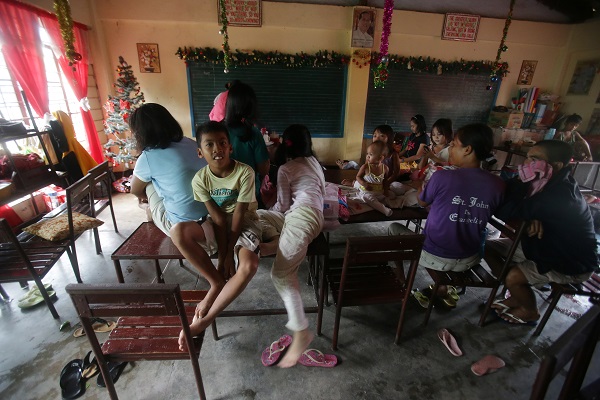
Evacuees stay inside a school as Typhoon Hagupit affects Legazpi, Albay province, eastern Philippines on Sunday, Dec. 7, 2014. Typhoon Hagupit slammed into the central Philippines’ east coast late Saturday, knocking out power and toppling trees in a region where 650,000 people have fled to safety, still haunted by the massive death and destruction wrought by a monster storm last year. AP
CEBU CITY, Philippines — Typhoon evacuees in the Visayas started returning to their homes on Monday even as thousands remained in evacuation centers needing food and other assistance.
Local government units had yet to account for the extent of damage left by typhoon “Ruby” (Hagupit) but many officials said early and better preparation resulted in minimal damage and casualties.
Government officials also excluded from the list of fatalities three persons, saying their deaths were not typhoon-related.
So far, eight persons were confirmed to have died due to Ruby in the Visayas.
These included the four-month-old girl in Calbayog City, Samar; the elderly couple in Sulat town, Eastern Samar; two in Cebu; one in Dolores town in Eastern Samar; one in Iloilo; and one in Catarman, Northern Samar.
The OCD in Western Visayas reported one fatality in the region as of Monday. The two others earlier reported – a one-year-old girl and a 35-year-old pregnant woman – were excluded because officials said their deaths were not related to the typhoon.
The local government of Dolores initially reported two people died due to Ruby. These were Valeriano Sumook and Juanito Nuguid.
Sumook reportedly died Thursday due to heart attack in fear of the coming strong typhoon. Naguid died after a tree fell on his house.
But on Monday, Sumook’s name was removed from the disaster office’s board because, disaster officials said, his death was not “typhoon-related.”
In Cebu, a 14-year-old boy was electrocuted inside their house in Malabuyoc town while a 60-year-old man died of hypothermia in Bogo City.
Church leaders said prayers and preparedness enabled communities to evade serious damage even as “Ruby” proved to be much weaker than last year’s Super Typhoon “Yolanda” (Haiyan), which packed winds reaching 300 kilometers per hour.
“This is the most massive pre-emptive evacuation I have experienced. There was better cooperation and coordination and these helped a lot,” Esperedion Pelaez, executive officer of the Provincial Disaster Risk Reduction Management Office of Capiz.
Capiz was among the most devastated areas in last year’s supertyphoon.
Pelaez said residents heeded calls to evacuate days before “Ruby” affected the province. At its peak, about 100,000 residents left their homes and stayed in evacuation centers all over the province.
A total of 49,780 families or 189,986 persons were evacuated in Western Visayas as of 11 a.m. Monday.
The evacuees were from 126 towns and 10 cities in the region, according to a report of the Office of Civil Defense in Western Visayas.
In Cebu, evacuees have also started returning to their homes.
Mayor Augusto Corro of Daanbantayan town told the Philippine Daily Inquirer that residents had left the evacuation centers to go back to their homes and clean up on Monday morning.
A total of 7,689 families were evacuated in the municipality as of 7 p.m. Sunday.
Corro said that food packs meant for evacuees would still be given out to residents, especially to families of fishermen who have not gone out to sea since Thursday.
He said there was “zero casualty” in his town because of the cooperation and preparedness of everybody, especially the residents.
Baltz Tribunalo, head of the Cebu Provincial Risk Reduction and Management Office, said that based on their initial reports from the province’s northern municipalities, 11 towns and one city were significantly affected by the typhoon that weakened on Monday into a tropical storm.
But he said teams including international and local non-government organizations would still assess the damage.
The damage to infrastructure that was initially reported included the municipal gym in Daanbantayan town, with the building’s roof ripped off by the strong winds.
Tribunalo lauded local government units for being well-prepared.
Aside from damage to the municipal gym, the typhoon damaged 12 private tour boats on Malapascua Island.
In Medellin town, Mayor Ricky Ramirez said residents had also returned to their houses as of 2 p.m. Monday.
In Bacolod City, Negros Occidental Gov. Alfredo Marañon Jr. called on Negrenses to thank God for sparing the province from the wrath of Typhoon “Ruby” and to heed the call of President Aquino to help those in areas affected most by the typhoon.
Provincial social welfare officer Liane Garcia said evacuees in Negros Occidental rose to 16,756 families or roughly 65,862 persons Sunday night as more people left their homes at the height of rains. But they began to go home by Monday.
The evacuees came from 21 towns and cities who stayed in 240 evacuation centers, Garcia said.
There were no reports of casualties or destroyed houses in the province as of Monday noon.
Despite minimal damage, several local government units placed their respective areas under a state of calamity to facilitate the release of funds covering relief aid to evacuees.
These included Aklan province and the towns of Cuartero, Maayon, Panay and Pilar in Capiz.
Classes were suspended in all levels in the provinces of Iloilo (except Iloilo City), Capiz and Aklan because many schools served as evacuation centers and the local governments decided to take precautionary measures to protect the students. Aklan and Capiz remained under Storm Signal No. 2 on Monday. With reports from Nestor P. Burgos Jr., Carmel Loise Matus, Carla P. Gomez and Karen Bermejo, Inquirer Visayas and Maricar Cinco, Inquirer Southern Luzon Bureau